Introduction
According to the Global Burden of Disease Study, 78% of deaths in Colombia in 2019 were due to non-communicable diseases (NCDs), of which 37% corresponded to cardiovascular diseases (1). In recent years, a slight but sustained increase has been observed in the trend of mortality rates due to coronary heart disease in Colombia, which increased from 69.3 cases per 100,000 inhabitants in 1990 to 87.3 in 2019 (1).
The growing problem of NCDs in Colombia, and in most countries of the world, is mainly explained by physical inactivity, smoking, habitual alcohol consumption, and unhealthy eating patterns. The latter represents the third risk factor linked to mortality in Colombia (1). A recent study found that, according to the nutrient profile of the Pan American Health Organization, 80% of the foods and groceries offered in supermarkets in Bogotá contain excessive amounts of one or more critical nutrients, including added sugars, sodium and saturated fats (2). To address this challenge, Law 2120 came into force in July 2021, which establishes the implementation of a nutritional labeling system with warnings of the main critical nutrients (3).
The objectives of the article are the following: (a) to provide information to civil society about general notions of fats, their classification, and the available evidence on the negative effect of excessive consumption of some of these on human health; (b) to characterize the fat content of foodstuffs and foods offered in Colombia; c) formulate conclusions based on the available evidence, aimed at promoting an adequate consumption of fats as part of a healthy eating pattern, and d) reinforce the importance of the implementation of Law 2120 of July 2021, given the current lack of sufficient regulation on the labeling of foods and foodstuffs in Colombia.
Fat consumption and human health
Lipids are an essential part of the human organism and fulfill fundamental functions of energy reserve, formation of cell membranes and synthesis of indispensable substances, such as some hormones and vitamins (4-6). The lipids that come from the diet are known as fats (solid) and oils (liquid) and are obtained from the consumption of natural foods or from processed foods. In addition, they are commonly present in the components of various ultra-processed foodstuffs, in which vegetable fats are modified by hydrogenation processes (6,7). For the purposes of this document, diet will be understood as the habitual consumption patterns of beverages, foods and foodstuffs.
Figure 1 shows fats according to their dietary origin and form of presentation in foods and foodstuffs, according to their presence in natural foods or their addition to ultra-processed foodstuffs, the concept of which will be explained in depth below (8-10).
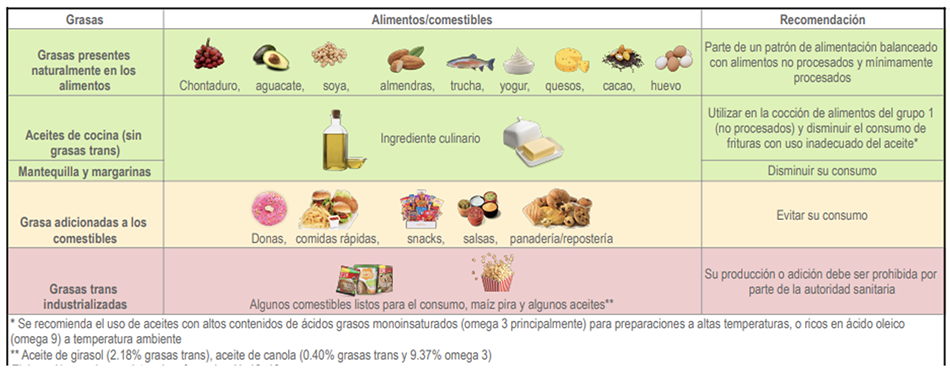
Source: Own elaboration with information taken from Cundiff DK, Lanou AJ, Nigg CR. Relation of omega-3 fatty acid intake to other dietary factors known to reduce coronary heart disease risk. Am J Cardiol. 2007;99:1230-3; Guasch-Ferré M, Zong G, Willett WC, Zock PL, Wanders AJ, Hu FB, et al. Associations of monounsaturated fatty acids from plant and animal sources with total and cause-specific mortality in two us prospective cohort studies. Circ Res. 2019;124(8):1266-75,and Resolution 2508/2012 of August 29, establishing the Technical Regulation on the requirements to be met by packaged foods containing trans fats and/or saturated fats. Ministry of Health and Social Protection.
Figure 1 Recommendations on the consumption of foods with naturally occurring fats vs. industrialized/additional fats and use of oils as culinary ingredients
Definition, classification and dietary sources of fats
Lipids are classified as saponifiable and non-saponifiable. The former, in turn, include acylglycerols, phosphoglycerides, sphingolipids, and waxes. In general terms, they are made up of fatty acids that are joined to glycerol by ester-like bonds, forming monoacylglycerols, di- or triglycerides. On the other hand, according to the degree of hydrogen saturation of their structure, they are classified into saturated fatty acids, which contain only single bonds; monounsaturated (MUFA), and polyunsaturated (PUFA), which contain one or more double bonds, respectively. They can also be classified according to the configuration of the hydrogen molecules in the fatty acids, into cis and trans, which significantly modify their functional properties (6).
Saturated fatty acids
Saturated fatty acids are found in solid form, due to their chemical composition, and can be of animal or vegetable origin. They are naturally present in dairy products, unprocessed meats and offal such as liver, as well as in frequently used oils such as palm and coconut oil. They are also found in industrialized products, such as processed meats, bakery and deli products and ultra-processed foods. The importance of moderate consumption in a balanced diet of saturated fats present in natural foods has been described, due to their role in the development of vital body functions (11).
However, high consumption of especially industrialized saturated fats has been associated with increased cardiovascular risk, at the expense of increased low-density lipoprotein (LDL), LDL/high-density lipoprotein (HDL) ratio, and the displacement of healthy sources of omega-3 and 6 (6). Tropical oils high in saturated fatty acids, such as coconut oil (92%), palm kernel oil (82%), and palm oil (50%), have uncertain effects on cardiovascular risk (12); whereas the evidence is stronger for palm oil consumption and increased risk of cardiovascular disease.
Unsaturated fatty acids
Unsaturated fatty acids are made up of the formerly called omega-3 and omega-6 families (today the name n-3 and n-6 fatty acids is preferred). The essential fatty acids (n-3 and n-6) receive this designation, since the human organism is incapable of producing them. Omega 9 (n-9), on the other hand, is one of the non-essential unsaturated fatty acids. The biotransformation derived from the ingestion of unsaturated fatty acids gives rise to specialized compounds such as thromboxanes, leukotrienes, prostaglandins and eicosanoids (6). Unsaturated fatty acids are further classified into MUFA and PUFA.
MUFA contain the omega 9 family, whose precursor is oleic acid, present in foods such as olives, olive oil, canola oil, avocado, macadamia, cocoa, nuts, pumpkin and sunflower seeds. It has beneficial effects complementary to those of omega-3 and omega-6 on HDL cholesterol (6,13,14). On the other hand, PUFA are:
Omega-6 family: to which belong linoleic acid, present in sunflower, corn, soybean, wheat, walnut, and pine nut oils; arachidonic acid, from the fat of animals fed with seeds and egg yolk; gamma-linolenic acid, and dihomo-gamma-linolenic acid. Although their consumption has not shown direct effects on all-cause mortality, it is known that a moderate consumption of omega-6, associated with a lower consumption of saturated fats, favors a decrease in cardiovascular risk (6,10).
Omega 3 family: corresponds to alpha-linolenic acid, present in nuts, chia seeds, flaxseed, flaxseed, soybeans and green leaves, finally transformed into eicosapentaenoic acid, also coming directly from cod liver oil, herring, salmon, sardines, shad and docosahexaenoic acid, found in blue fish (such as tuna), nuts, seaweed, almonds and eggs.
Some types of oils, such as olive, corn, and sesame, are very unstable at high temperatures, so they should ideally be used fresh since during the cooking process they increase their omega 6 content (instead of oleic acid or omega 9). During the last few years, not only has the consumption of fatty acids from these three families been encouraged, whose health benefits have been described on multiple occasions, but also the concept of the importance of a ratio of omega 6 to omega 3 consumption no greater than 5:1 or 10:1 in the case of adult men and women, respectively, has been introduced, because from this point on, they can favor the risk of cancer, cardiovascular disease and inflammatory diseases (6,13,14).
In Latin America, specifically in Mexico, a consumption ratio of 36:1 has been described, which is alarming, considering the detrimental effects on health over the possible benefits (6). In a study conducted in Colombia (15), very high omega 6/omega 3 ratios were found in some oils frequently consumed by humans (Table 1).
Table 1 Quantity of fatty acids (grams per 100 g) in oils for human consumption available in Colombia, omega 6/omega 3 ratio
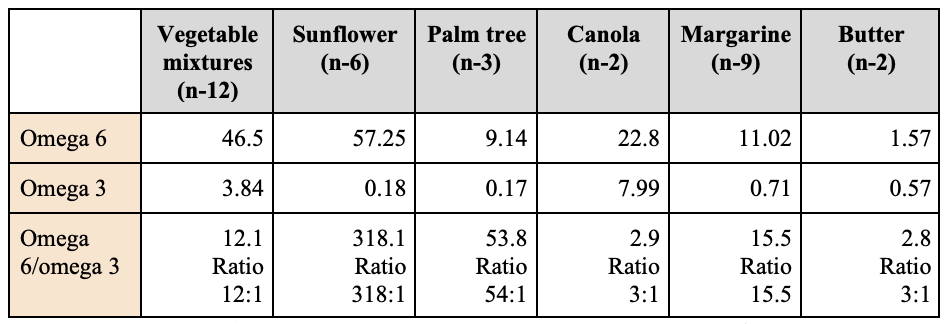
Source: Own elaboration with information based in Baylin A, Mora-Plazas M, Cobos-De Rangel O, López-Arana S, Campos H, Villamor E. Predictors of usage and fatty acid composition of cooking fats in Bogotá, Colombia. Public Health Nutr. 2009;12(4):531-7.
Trans fats
Trans fats are a type of fatty acid that are naturally present in foods such as milk and meat from ruminants (cows, goats, and sheep) by biohydrogenation or are obtained from the partial hydrogenation of vegetable or fish oils. In recent years, a positive association has been established between the consumption of trans fats of industrial origin and the risk of cardiovascular disease, mainly mediated by an increase in LDL cholesterol and a decrease in HDL cholesterol, by mechanisms that do not depend solely on the caloric intake generated (1,9,10).
In the case of industrialized trans fats, unlike those of animal origin, an enhanced pro-inflammatory and oxidative effect has been demonstrated that favors atherogenicity mediated by activation of inflammatory cascades dependent on C-reactive protein, tumor necrosis factor (TNF) α, chemokines, interleukin-6, among others; while in the case of trans fats from ruminants, anti-inflammatory properties have been described associated with their interaction as a ligand of the PPAR-γ receptor (peroxisome proliferator-activated receptor) with a decrease in interleukin-2 and TNF-α, as well as with a modification of cell differentiation of blood lines and adipocytes and impact on glycemic control, since their activation enhances peripheral sensitivity to insulin (10,13,15). Because of this, it is recommended to avoid the consumption of ultra-processed, packaged, and ready-to-eat foods rich in trans fats of industrialized origin (8).
Among the industrialized trans fats are those added to ultra-processed foods, fast foods, packaged foods, and vegetable oils, which are frequently used for the preparation of various foods and which in the case of Colombia, for the most part, present concentrations 2% higher than those recommended by the Pan American Health Organization (16). However, given the description of the harmful effects that the consumption of this type of fats has on health, the nutritional profile of oils marketed in large supermarkets has shown a significant improvement, with a significant reduction in the amounts of trans fats. By 2013, sunflower oil reported an average trans fat content of 2.18%; while canola oil reported 0.40% (reduction of 65%-89%) with increased omega-3 content, which, given the low average consumption of oily fish in Colombia, justifies the current recommendation to prefer the use of the latter for the preparation of food at high temperatures in moderate quantity (16). However, there are other factors identified in the Colombian population as predictors of the choice of cooking oils, which will be discussed later.
Regulatory mark
Until a few months ago, the Colombian regulations regarding the regulation of trans and saturated fat content was given by Resolution 2508 of 2012 (17), which applied to oils, fats, and all packaged or packaged foods marketed for human consumption with trans fats or saturated fats, except those that have them naturally, such as ruminant meats, their derivatives, and dairy products. It established that there should be clarity in the labeling of the content of trans fats or saturated fats not susceptible to confusion, being truthful and declaring the amount in grams per serving, additionally limiting the contribution of trans fats in the different products: for direct sale to the consumer, not to exceed 2 g of trans fats per 100 g of fat, or as an input for the food industry, the limit of 5 g of trans fats per 100 g of fat. If it is greater than 5 g, a whole number is expressed, but if it is less than 5 g, it is expressed in 0.5 g increments. If the content is less than 0.5 g, it is expressed as zero. If the saturated fat content is equal to or greater than 0.5 g per serving, it should be presented in a mandatory manner (17).
Regarding surveillance and control by the Government, it is established that the National Institute for Drug and Food Surveillance will take samples and quantify them in the reference laboratory (17).
With the recent approval of Law 2120 of 2021, which establishes the technical regulation on labeling requirements for packaged foods for human consumption, those who produce and market packaged products are made responsible for providing truthful and transparent information on the nutritional components of the products, not only fats but also sugars and sodium. At this point, it is worth mentioning the document adapted from other countries such as the United States or Canada, presented by the Ministry of Health and Social Protection of Colombia, called Recommendations for energy and nutrient intake, from 2016, as a method to estimate the number of calories and nutrients that should be ingested to achieve a state of optimal health and well-being, establishing some recommendations according to age, sex, gender, physiological state (growth, gestation or lactation period) and physical activity, to prevent inadequate eating practices. It is considered a reference point concerning the factors associated with food and nutrition in the country (3).
Nutritional profile of foodstuffs available in Colombia
Due to the globalization and growth of the food industry, the availability of processed and ultra-processed products for consumption has increased significantly. According to the 2015 Food and Nutrition Situation Survey in Colombia, the consumption of processed and ultra-processed foods in the country exceeds 50%, even reaching figures above 90%, and this allows for the implementation of unhealthy eating behaviors, increased rates of overweight and obesity in all age groups, among other factors associated with the development of NCDs (18).
Although in Colombia, so far, the initiatives that regulate the labeling standards or labeling of food and groceries are being developed, in 2016 a cross-sectional study was conducted that compared the adjustment of packaged products available in Colombia with the nutritional profiles recommended by the Pan American Health Organization and the Chilean model (based on the Food Labeling and Advertising Law in Chile), to estimate the percentage of packaged foods and beverages available in Colombia that should present an alert in their labeling as a warning about excess sugar, sodium, added saturated fats or unhealthy sweeteners based on what is reported on the label and nutritional table. The Chilean model was taken into account as a comparator since it has been used as a reference in Latin American countries, including Colombia (2), as it has proven to be effective in discouraging the consumption of unhealthy foodstuffs through octagonal warnings of certain components. Although it is evident, this measure should be accompanied by restrictions on advertising and distribution in school environments to enhance its impact (19,20).
The products were collected from stores located in low, medium and high socioeconomic sectors in the city of Bogotá and were classified into 12 categories (beverages, bread or bakery products, ready-to-eat groceries, dairy products, fish or seafood products, fruits, vegetables, nuts and legumes, meats, sauces, dressings and sauces, snacks, sweets, and others) (2).
Figure 2 shows comparatively the percentage of foodstuffs or foods in each category that, according to the nutritional profiles described, presented, for 2016, excess in one or more of their components. This suggests that they may require regulation on their labeling. Of the total number of foodstuffs analyzed, 80.2% and 66.4% do not meet the criteria suggested by the nutritional profile of the Pan American Health Organization or the Food Labeling and Advertising Law in Chile, respectively.
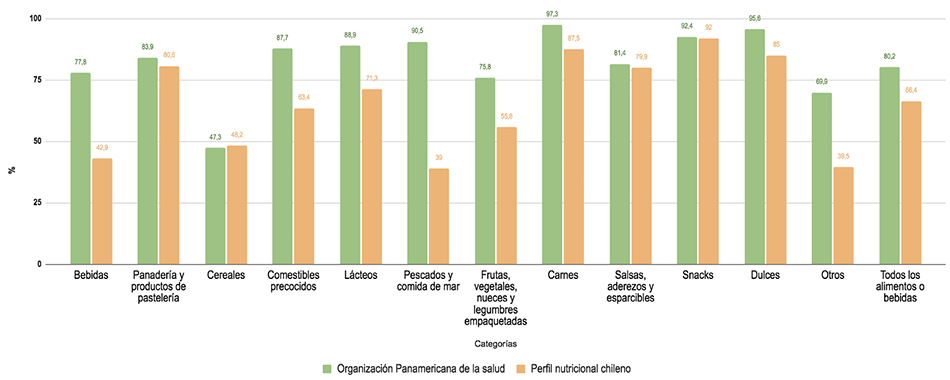
Source: Own elaboration with information taken from Mora-Plazas M, Gómez LF, Miles DR, Parra DC, Taillie LS. Nutrition quality of packaged foods in Bogotá, Colombia: a comparison of two nutrient profile models. Nutrients. 2019;11(5):1-13.
Figure 2 Groceries and packaged foods offered in supermarkets in Bogota that need labeling regulation (%)
In addition, an individual analysis was made by categories of foods that did not meet these criteria, characterizing each of their components according to the recommendations of the nutritional models. The results are shown in Figures 3 and 4 (2). Specifically, concerning fat content, the foods with the highest excess of saturated fats were confectionery/bakery products, precooked foods, dairy products, meats, and sweets; while in the case of trans fats, the categories with the highest content were precooked foods and dairy products (2).
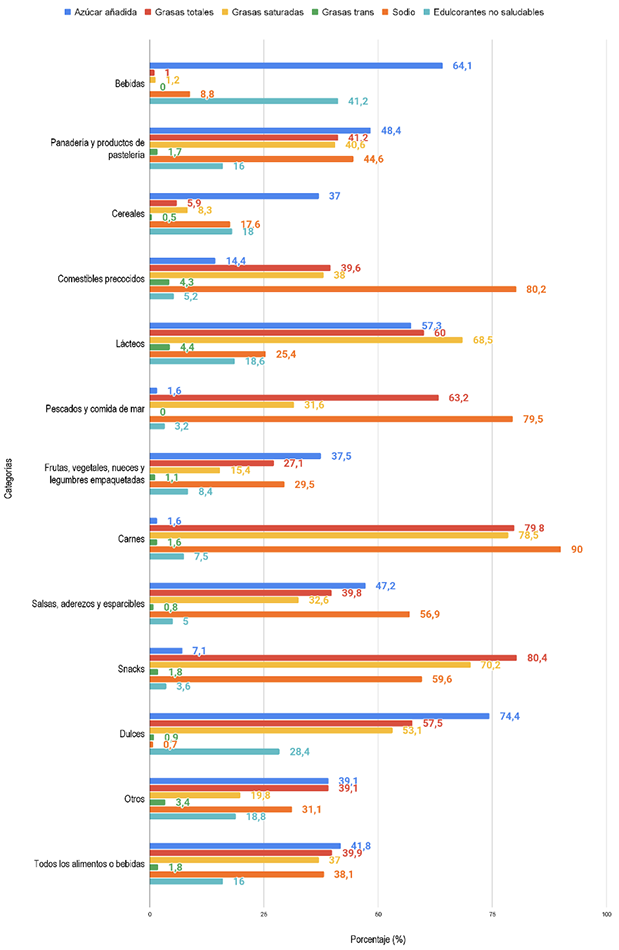
Source: Own elaboration with information taken from Mora-Plazas M, Gómez LF, Miles DR, Parra DC, Taillie LS. Nutrition quality of packaged foods in Bogotá, Colombia: a comparison of two nutrient profile models. Nutrients. 2019;11(5):1-13.
Figure 3 Percentage of groceries and packaged foods offered in supermarkets in Bogotá (2016) that have an excess of critical nutrients, according to the PAHO nutritional profile
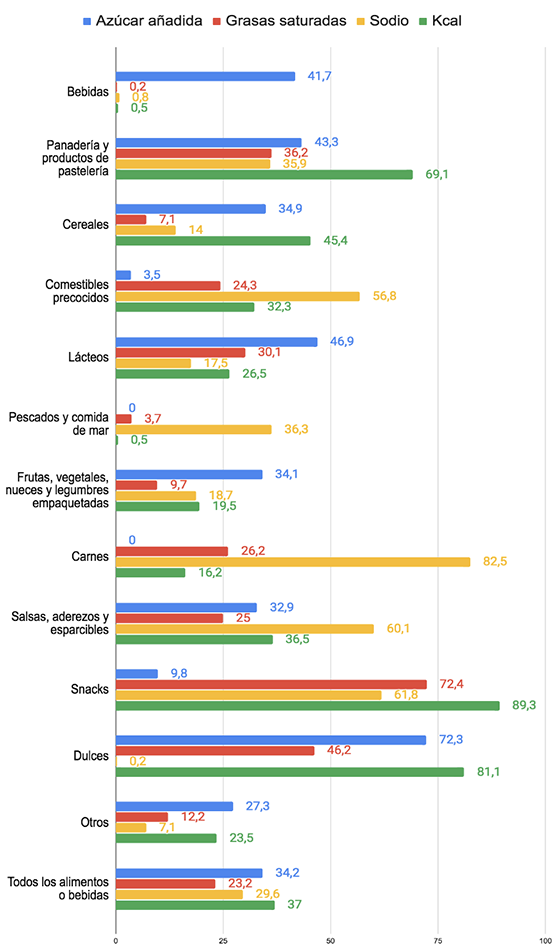
Source: Own elaboration with information taken from Mora-Plazas M, Gómez LF, Miles DR, Parra DC, Taillie LS. Nutrition quality of packaged foods in Bogotá, Colombia: a comparison of two nutrient profile models. Nutrients. 2019;11(5):1-13.
Figure 4 Percentage of groceries and packaged foods offered in supermarkets in Bogota (2016) that have excess of critical nutrients, according to the nutritional profile of Chile
Composition and use of cooking oils offered in supermarkets in different cities of Colombia.
In Colombia, according to a study published in 2009, blended oils are the most widely used (65.57%) and contain soybean, corn and palm oil, with a high content of saturated fatty acids. The second most consumed oil is sunflower oil and, paradoxically, the main reason associated with its choice is the perception of "healthy" that prevails in the general population, despite its high trans fat content and low omega-3 content, in addition to its pleasant taste (15).
Initially, in 2013, with the study by Moynihan et al. (16), it was possible to characterize the composition of oils in Colombia. There is an average distribution of 89 oil brands available, represented in Figure 5. This study showed a higher content of both saturated fats and omega 6 in soybean and sunflower oil, as well as a higher contribution of omega 3 in canola and soybean oils. On the other hand, in terms of trans fat content, sunflower oil ranked first with 2.18%, followed by blended oils with 1.67%.
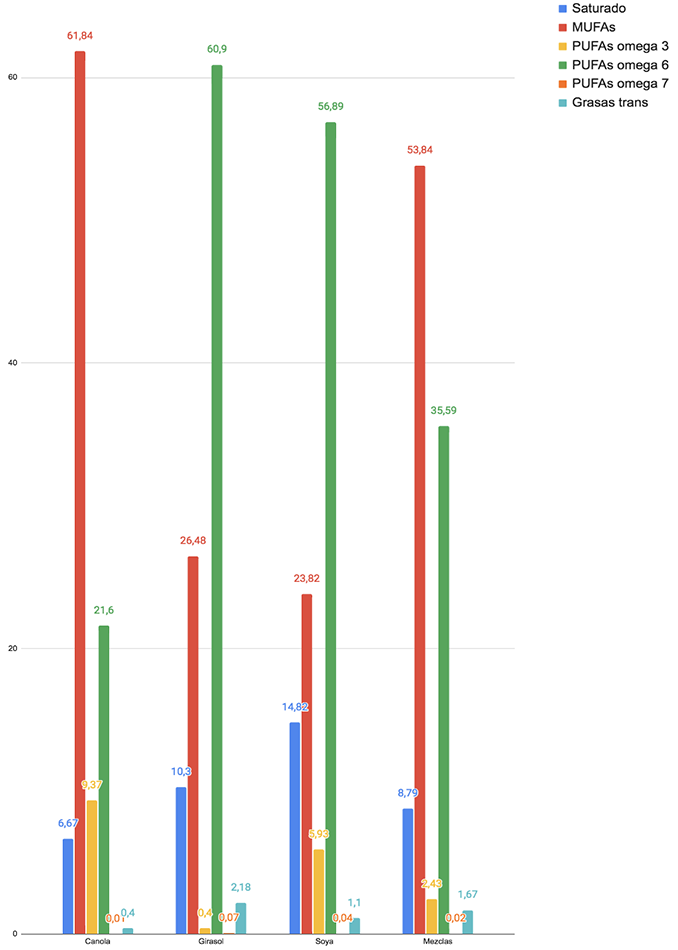
Source: Own elaboration with information taken from Baylin A, Mora-Plazas M, Cobos-De Rangel O, López-Arana S, Campos H, Villamor E. Predictors of usage and fatty acid composition of cooking fats in Bogotá, Colombia. Public Health Nutr. 2009;12(4):531-7.
Figure 5 Composition of the cooking oils offered in Colombia
Subsequently, in 2018, a database was developed with support from the University of North Carolina, in which information was collected about 224 brands offered in 4 cities in Colombia, to characterize the distribution of fatty acids that make up each of the brands, according to what is reported in the nutritional table. A total of 154 brands that provided complete nutritional labeling were included. However, the trans fat content was not until then a mandatory part of the nutritional table included in the label, although, during the analysis of these, trans fat content was identified in probable relation to refining and hydrogenation processes whose purpose is to modify the biochemical and physical properties of the product, including its consistency, which becomes solid as the trans and saturated fat content increases, as is the case of a large percentage of margarine, which mostly provide a high content of these fatty acids (15).
Figure 6 summarizes the findings obtained. Concerning saturated fats, an average content of 15.7% is striking, even though it is higher than 10% for olive, sunflower, mixed oils, soybean, sesame, and avocado oil. On the other hand, the highest MUFA content is found in olive, canola, sesame, and avocado oil. Finally, in the case of PUFA, these predominate in sacha inchi, soybean, grape, sunflower, and sesame oils; but, as already explained, a rational use is encouraged only as part of the food preparation or cooking process, due to the risks involved in a high consumption ratio of omega 6, typical of this type of oils, with respect to omega 3 (6,13,14).
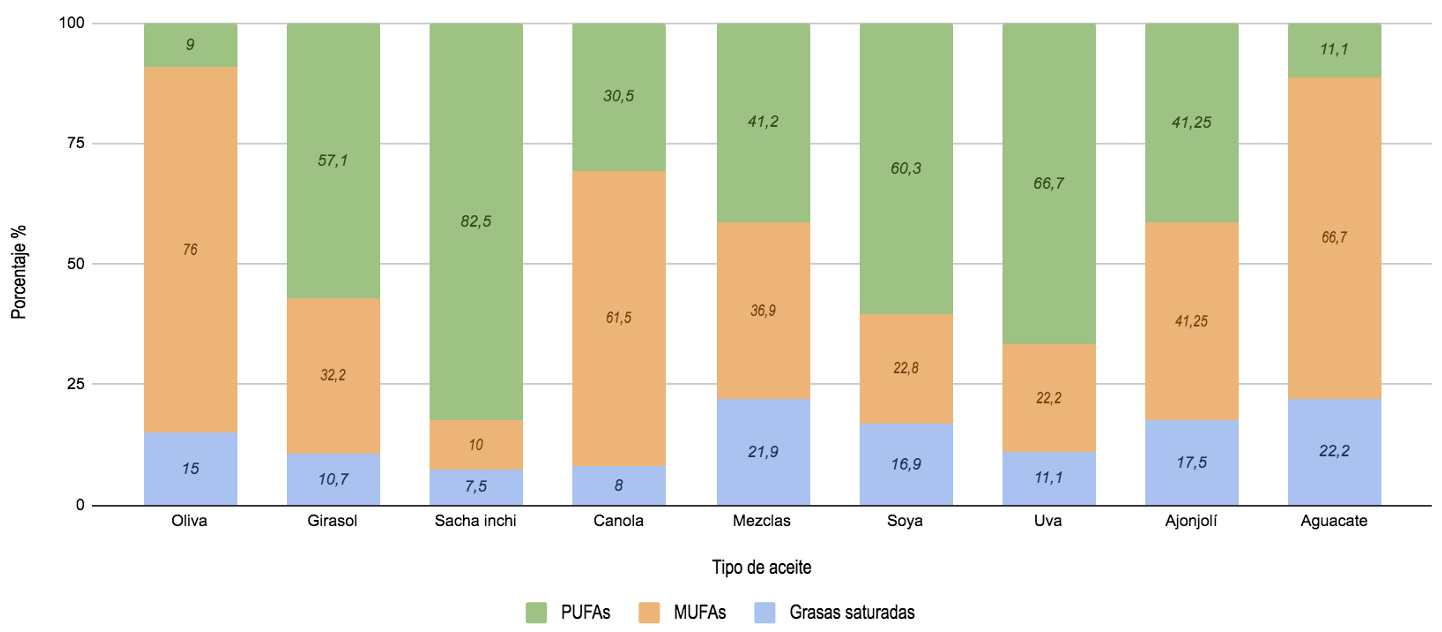
Source: Own elaboration with information taken from Mora-Plazas M, Gómez LF, Miles DR, Parra DC, Taillie LS. Nutrition quality of packaged foods in Bogotá, Colombia: a comparison of two nutrient profile models. Nutrients. 2019;11(5):1-13.
Figure 6 Composition of cooking oils offered in supermarkets in four cities of the country
In recent years, in search of new processes to achieve a nutritional profile that meets the recommendations, new processing techniques have been introduced, such as fat interesterification, which can be enzymatic or chemical and consists of a rearrangement of fatty acids and triglycerides, which allows modifying their smoke points (surface This process has been used mainly for the development of spreadable products, pastry or confectionery products, snacks, etc.; however, although it allows reducing the contribution of trans or saturated fats in the different products, it is still not clear the effect that its chronic consumption could have on health (21).
Consumption of fried food in Colombia
An extensive review published in 2015 concluded that there is strong evidence about the frequent consumption of fried foods and their relationship with an increased risk of type 2 diabetes mellitus, heart failure, obesity, and arterial hypertension. However, the evidence related to the occurrence of cardiovascular disease is contradictory, possibly because the studies do not take into account the particular type of oil used by individuals (22), added to the great variability in the percentages of saturated, trans fats, and unsaturated fatty acids in the different oils. Even storage and cooking conditions can alter the properties and components reported on labels (23). This is the case of oils rich in unsaturated fatty acids, which have benefits for cardiac health; however, frying processes can alter their chemical composition by thermodegradation of lipids, which incidentally modifies their impact on health, since these reactions generate trans fats, which increase cardiovascular risk and displace healthy sources of n-3 or n-6 fatty acids (22-24).
The global availability of low-cost vegetable oils has caused an increase in the consumption of fats in Colombia, mainly as a culinary ingredient for frying food. Fried foods are easily accessible because of their low cost, associated gastric satiety, pleasant taste, and crunchy texture (16).
Studies that have sought to determine the sociodemographic characteristics associated with the consumption of different oils by the Colombian population have found a close relationship between socioeconomic status and the consumption of vegetable oil blends, compared to other options that can be considered healthier, since they have a lower percentage of trans fats, such as canola oil or olive oil. However, due to the new interesterification processes, the greatest current problem is the high concentration of saturated fats, which predominate in sunflower oil and oil blends, both frequently used by the Colombian population due to their low cost and accessibility, and in the case of families with higher incomes, chosen due to the perception of being healthy oils at the time of acquiring them. However, studies have reflected, paradoxically, a higher content of saturated and trans fats when compared to vegetable oil blends available for purchase or consumption in Bogotá (16).
In Colombia, there are typical foods, such as empanadas, cheese sticks, French fries, fritters, chicken, and meat pies, among others, whose preparation requires the use of oils, which are frequently reused, resulting in undesirable conformational changes, both in the oil and in the food, mainly in those that are widely available, either because of easy access, low cost or short preparation time required (23,24).
Food and nutrition education in Colombia
As in other Latin American countries, food consumption or limitation has been guided by fear and misinformation rather than by the individualization of each person or social group, based on psychosocial, cultural, and economic factors. In Colombia, education related to food and nutrition has become relevant since the implementation of public policies and development plans.
In a study conducted by the Food and Agriculture Organization of the United Nations (FAO) on "Good practices in information and communication programs in food and nutrition education", where 19 countries were selected, including Colombia, it was identified that food education lacks importance, as well as financial support and trained personnel to disseminate information, among other items. Additionally, it was found that in Colombia erratic feeding behaviors start in early childhood, for example, the short duration of exclusive breastfeeding, low consumption of fruits and vegetables, and increased consumption of fast food and packaged foods, which has an impact on future adults and the development of NCDs.
The Colombian Institute of Family Welfare and FAO designed food guides aimed at the general population, consumers, educators, media, and personnel related to the food industry, in which the population is divided into different groups and seeks to deliver basic guidance tools to improve the food and nutritional situation, based on the results of the last nutritional status survey of 2015—for example, in the group of children under two years, pregnant women and breastfeeding mothers, in addition to information that promotes food with high nutritional content. It also has guidance for attending prenatal checkups, in which questions about feeding can be resolved and nutritional supplements can be obtained if required; they include emotional support, recognition of the benefits of breastfeeding, the proper introduction of complementary feeding, among others.
The guidelines aim to contribute promoting healthy lifestyles and to take into account the benefits of controlling food consumption, according to its nutritional value (25). At this point, it is important to reflect on the education of parents and caregivers, emphasizing the importance of eating habits and traditional cuisines, with the production and consumption of fresh foods free of excess nutrients and substances characteristic of industrialized food (23). This should be supported by the approval of the junk food law or Law 2120, whose objective is to provide clear and complete information on the ingredients and their percentage in foods ready for human consumption, as well as their relationship with different diseases and the maximum suggested content for consumption (3).
With the above information as a preamble, it is recognized that the dissemination of information is necessary to encourage healthy eating practices. With the new political references, it is expected that the population will have at their disposal relevant information, which in the long term will have a positive effect on their health.
Conclusions
The consumption of saturated fatty acids and trans fats has pro-inflammatory and oxidative effects that favor atherogenesis processes, increase LDL cholesterol, and, therefore, increase cardiovascular risk.
n-6 and n-3 (unsaturated) fatty acids are an essential part of recommended nutritional patterns; however, they should retain a ratio of less than 1:5 and 1:10 for adult men and women, respectively, because otherwise the risk of cancer and chronic non-communicable or inflammatory diseases increases.
Fats are a fundamental part of the diet, given the minimum nutritional requirements of the human body. However, the proportion of saturated fats and trans fats is higher in ultra-processed foods compared to natural foods.
According to scientific evidence, it is necessary to ban industrialized trans fats in cooking oils and replace them with unsaturated fatty acids, including the so-called essential ones, which bring health benefits.
The effects on cardiovascular risk derived from oils have a dose-response pattern, i.e., their use should be moderate in frequency and quantity. It should be taken into account that in the case of olive, corn, and sesame oils, mainly, their instability, when exposed to high temperatures, increases their detrimental effects on health.
The new Law 2120 of 2021 allows regulating the labeling of food and groceries, to provide a more appropriate notion of their nutritional components, including alerts on the excess of saturated fats, among other elements related to NCD development.
Health authorities should have a greater capacity to intervene in the food industry companies, not only to monitor and control the nutritional contribution they provide, but also to implement strategies similar to those used in other Latin American countries, which have led to improvements in labeling and advertising with an impact on consumption and health benefits.











 text in
text in 



